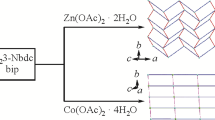Abstract
The reactions of zinc, nickel(II), and manganese(II) acetate hydrates with excess trifluoroacetic acid in boiling 1,4-dioxane give coordination polymers (CPs): {[Zn3(µ-OH2)2(µ-OOCCF3)4(OOCCF3)2(OH2)2] [µ-O(CH2CH2)2O)]·3O(CH2CH2)2O}n (1, 81% yield), {[Ni2(µ-OH2)(µ-OOCCF3)2(OOCCF3)2 (OH2)2(O(CH2CH2)2O)]2[µ-O(CH2CH2)2O)]·5O(CH2CH2)2O}n (2, 89% yield), and {[Mn2(µ-OOCCF3)3(OOCCF3)(OH2)][µ-O(CH2CH2)O]2}n (4, 79% yield). According to X-ray diffraction data, the CP structure is determined by the nature of the transition metal. In polymer 1, the trinuclear Zn3(µ-OH2)2(µ-OOCCF3)4(OOCCF3)2(OH2)2 moieties (Zn···Zn, 3.6490(3) Å) are linked by bridging dioxane molecules to give zigzag-like 1D-CP, while the hydrogen atoms of coordinated water molecules form 2D-CP via intermolecular hydrogen bonds (HBs) with oxygen atoms of solvation solvent molecules. In CP 2, two binuclear Ni2(µ-OH2)(µ-OOCCF3)2(OOCCF3)2(OH2)2(O(CH2CH2)2O moieties (Ni···Ni, 3.5388(13) Å) in the tetranuclear Ni4 complex are linked by a bridging dioxane molecule, while the terminal and solvation solvent molecules form intermolecular HBs with the hydrogen atoms of the peripheral water molecules, thus giving 2D-CP. In the case of most electron-deficient Mn(II) ion, each metal atom in the binuclear complex Mn2(µ-OOCCF3)3(OOCCF3)(OH2) (Mn···Mn, 4.2487(5) Å) is bound to two bridging dioxane molecules to give 2D-CP, the dimensionality of which increases to 3D via the formation of intermolecular HBs between the terminal water molecule and the oxygen atom of the terminal and bridging carboxylate anion. It was also shown that in a similar reaction of Ni(OOCMe)2(OH2)4 with 2 moles of HOOCCF3 at room temperature, only anion exchange takes place, resulting in the polymer {Ni(OOCCF3)2(OH2)4⋅[O(CH2CH2)2O]}n (3). Apart from X-ray diffraction, the CPs were studied by chemical analysis and IR spectroscopy.










Similar content being viewed by others
REFERENCES
F. A. Cotton, G. Wilkinson, C. A. Murillo, and M. Bochmann, Advanced Inorganic Chemistry (Wiley, New York, 1999).
R. C. Mehrotra and R. Bohra, Metal Carboxylates (Academic, London, 1983).
M. Becht, T. Gerfin, and K.-H. Dahmen, Helv. Chim. Acta 77, 1288 (1994). https://doi.org/10.1002/hlca.19940770511
R. C. Pratt, L. M. Mirica, and T. D. P. Stack, Inorg. Chem. 43, 8030 (2004). https://doi.org/10.1021/ic048904z
Z. Tomkowicz, S. Ostrovsky, S. Foro, et al., Inorg. Chem. 51, (2012). https://doi.org/6046 10.1021/ic202529p
E. A. Mikhalitsyna, V. S. Tyurin, S. E. Nefedov, et al., Eur. J. Inorg. Chem. 36, 5979 (2012). https://doi.org/10.1002/ejic.201200868
S. Hiroto, K. Furukawa, H. Shinokubo, and A. Osuka, J. Am. Chem. Soc. 128, 12380 (2006). https://doi.org/10.1021/ja062654z
A. A. Sinelshchikova, S. E. Nefedov, Yu. Yu. Enakieva, et al., Inorg. Chem. 52, 999 (2013). https://doi.org/10.1021/ic302257g
I. L. Eremenko, V. M. Novotortsev, A. A. Sidorov, and I. G. Fomina, Ros. Khim. Zh. 48, 49 (2004).
H. Becker, G. Domschke, E. Fanghänel, and M. Fischer, Organikum, Organisch-chemisches Grundpraktikum (VEB Deutscher Verlag der Wissenschaften, Berlin, 1990; Mir, Moscow, 1992).
SMART (Control) and SAINT (Integration) Software, Version 5.0, Bruker AXS, Inc. Madison, WI, 1997.
SMART: Area-Detector Integration Software, Bruker, Madison, WI, 603, 2012
G. M. Sheldrick, SADABS, Program for Scaling and Correction of Area Detector Data, Univ. of Göttingen (1997).
G. M. Sheldrick, Acta Crystallogr. C 71, 3 (2015). https://doi.org/10.1107/S2053229614024218
M. A. Uvarova and S. E. Nefedov, Russ. J. Coord. Chem. 46, 608 (2020). https://doi.org/10.1134/S1070328420090079
V. Calvo-Perez, S. Ostrovsky, A. Vega, et al., Inorg. Chem. 45, 64410 (2006). https://doi.org/1021/ic051361o
A. O. Tokareva, D. S. Tereshchenko, A. I. Boltalin, et al., Russ. J. Coord. Chem. 32, 691 (2006). https://doi.org/10.1134/S1070328406090077
I. V. Morozov, E. V. Karpova, T. Yu. Glazunova, et al., Russ. J. Coord. Chem. 42, 647 (2016). https://doi.org/10.1134/S107032841610002X
F. Calderazzo, U. Englert, G. Pampaloni, et al., Can. J. Chem. 79, 495 (2001). https://doi.org/10.1139/cjc-79-5-6-495
C. P. Guntlin, Zund. Tanja, K. V. Kravchyk, et al., J. Mater. Chem. A 5, 7383 (2017). https://doi.org/10.1039/C7TA00862G
B. D. Dhanapala, N. A. Mannino, L. M. Mendoza, et al., Dalton Trans. 46, 1420 (2017). https://doi.org/10.1039/C6DT04152C
Z. Olejnik and T. Lis, Acta Crystallogr., Sect.C: Cryst. Struct. Commun. 56, 1310 (2000). https://doi.org/10.1107/S0108270100011215
M. A. Uvarova and S. E. Nefedov, Russ. J. Coord. Chem. 47, 839 (2021). https//doi.org.10.31857/S0132344X21060086
CSD, version 5.42 (November 2020).
ACKNOWLEDGMENTS
X-ray diffraction studies of the complexes and IR spectral studies were performed using research equipment of the Center for Collective Use of the Physical Investigation Methods of the Kurnakov Institute of General and Inorganic Chemistry, Russian Academy of Sciences, supported by the state assignment for the Kurnakov Institute of General and Inorganic Chemistry, Russian Academy of Sciences, in the field of fundamental research.
Funding
This study was supported by the state assignment for the Kurnakov Institute of General and Inorganic Chemistry, Russian Academy of Sciences in the field of fundamental research.
Author information
Authors and Affiliations
Corresponding author
Ethics declarations
The authors declare that they have no conflicts of interest.
Additional information
Dedicated to the 80th anniversary of Professor Aleksandr Anatol’evich Pasynskii’s birth. In Memory of the Teacher
Translated by Z. Svitanko
Rights and permissions
About this article
Cite this article
Uvarova, M.A., Nefedov, S.E. Coordination Polymers of Zinc, Nickel(II), and Manganese Trifluoroacetates with 1,4-Dioxane. Russ. J. Inorg. Chem. 66, 839–851 (2021). https://doi.org/10.1134/S0036023621060206
Received:
Revised:
Accepted:
Published:
Issue Date:
DOI: https://doi.org/10.1134/S0036023621060206




